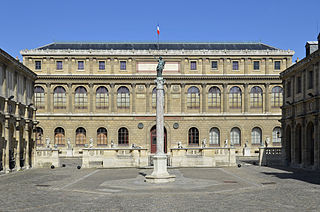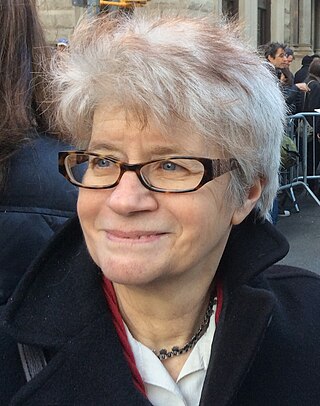Related Research Articles

The Kansas City Art Institute (KCAI) is a private art school in Kansas City, Missouri. The college was founded in 1885 and is an accredited by the National Association of Schools of Art and Design and Higher Learning Commission. The institute has approximately 75 faculty members and 700 students, and offers a Bachelor of Fine Arts degree.

Alice Neel was an American visual artist. Recognized for her paintings of friends, family, lovers, poets, artists, and strangers, Neel is considered one of the greatest American portraitists of the 20th century. Her career spanned from the 1920s to 1980s.
Philip Martin Pearlstein was an American painter best known for Modernist Realist nudes. Cited by critics as the preeminent figure painter of the 1960s to 2000s, he led a revival in realist art.
The Bay Area Figurative Movement was a mid-20th-century art movement made up of a group of artists in the San Francisco Bay Area who abandoned working in the prevailing style of Abstract Expressionism in favor of a return to figuration in painting during the 1950s and onward into the 1960s.
The 10th Street galleries was a collective term for the co-operative galleries that operated mainly in the East Village on the east side of Manhattan, in New York City in the 1950s and 1960s. The galleries were artist run and generally operated on very low budgets, often without any staff. Some artists became members of more than one gallery. The 10th Street galleries were an avant-garde alternative to the Madison Avenue and 57th Street galleries that were both conservative and highly selective.
The California Art Club (CAC) is one of the oldest and most active arts organizations in California. Founded in December 1909, it celebrated its centennial in 2009 and into the spring of 2010. The California Art Club originally evolved out of The Painters Club of Los Angeles, a short-lived group that lasted from 1906–09. The new organization was more inclusive, as it accepted women, sculptors and out-of-state artists.

New York Figurative Expressionism is a visual arts movement and a branch of American Figurative Expressionism. Though the movement dates to the 1930s, it was not formally classified as "figurative expressionism" until the term arose as a counter-distinction to the New York–based postwar movement known as Abstract Expressionism.

École des Beaux-Arts refers to a number of influential art schools in France. The term is associated with the Beaux-Arts style in architecture and city planning that thrived in France and other countries during the late nineteenth century and the first quarter of the twentieth century.

American Figurative Expressionism is a 20th-century visual art style or movement that first took hold in Boston, and later spread throughout the United States. Critics dating back to the origins of Expressionism have often found it hard to define. One description, however, classifies it as a Humanist philosophy, since it is human-centered and rationalist. Its formal approach to the handling of paint and space is often considered a defining feature, too, as is its radical, rather than reactionary, commitment to the figure.
The contemporary realism movement is a worldwide style of painting which came into existence c. 1960s and early 1970s. Featuring a straightforward approach to representation practiced by artists such as Philip Pearlstein, Alex Katz, Jack Beal and Neil Welliver. The movement refers to figurative art works created in a natural yet highly objective style. Today the term Contemporary Realism encompasses all post-1970 sculptors and painters whose discipline is representational art, where the object is to portray the "real" and not the "ideal".
Lester Johnson was an American artist and educator. Johnson was a member of the Second Generation of the New York School during the late 1950s. The subject of much of his work is the human figure. His style is considered by critics and art historians to be in the figurative expressionist mode.
John Lucas Perreault was a poet, art curator, art critic and artist.
Walter Henry "Jack" Beal Jr. was an American realist painter.
Women's Art Resources of Minnesota (WARM) is a women's art organization based in the U.S. state of Minnesota. It was founded in 1976 as Women's Art Registry of Minnesota, a feminist artist collective. The organization ran the influential WARM Gallery in downtown Minneapolis from 1976 to 1991.
Philip Pavia (1911-2005) was a culturally influential American artist of Italian descent, known for his scatter sculpture and figurative abstractions, and the debate he fostered among many of the 20th century's most important art thinkers. A founder of the New York School of Abstract Expressionism, he "did much to shift the epicenter of Modernism from Paris to New York," both as founding organizer of The Club and as founder, editor and publisher of the short-lived but influential art journal It Is: A Magazine for Abstract Art. Reference to the magazine appears in the archives of more than two dozen celebrated art figures, including Picasso, Peggy Guggenheim, and art critic Clement Greenberg. The Club is credited with inspiring art critic Harold Rosenberg’s influential essay “The American Action Painters" and the historic 9th Street Show.

Marjorie Kramer is a figurative painter of al fresco landscapes and feminist self-portraits.
The Club has been called "a schoolhouse of sorts ... as well as a theater, gallery space, and a dancehall...." Created by abstract expressionist sculptor Philip Pavia, The Club grew out of the informal gatherings among dozens of painters and sculptors who all had art studios in Lower Manhattan between 8th and 12th streets and First and Sixth Avenues during the late 1940s and early 1950s. Membership included many of New York's most important mid-century artists and thinkers, predominantly painters and sculptors like Willem de Kooning, Franz Kline, Isamu Noguchi, John Ferren, and Robert Motherwell, as well as nearly all the artists later called the New York School. But other celebrated artists, cultural figures and major 20th-century thinkers attended meetings, including philosopher Joseph Campbell, composer John Cage and political theorist Hannah Arendt. Structured to facilitate the growth and dissemination of ideas about art by artists for artists, especially abstract expressionist art, The Club lent New York's art scene the vitality and international influence Paris had long monopolized, and U.S. artists had long craved.
It is. A Magazine for Abstract Art was an influential limited edition fine arts magazine that only published six issues in its seven years of existence. Founded by the abstract expressionist sculptor Philip Pavia, the magazine's contributors included a who's who of some of the 20th century's most important artists. Although it primarily focused on painters and sculptors like Willem de Kooning, Franz Kline, Helen Frankenthaler, Jackson Pollock and Isamu Noguchi, it also published artists of other kinds, like musician John Cage and poet Allen Ginsberg. Collectively, the magazines served to catalyze, and catalogue, the contemporaneous life cycle of abstract expressionist thought, from creation to mature expression. Reference to the magazine appears in the archives of Picasso, Motherwell and André Breton, as well as collector Peggy Guggenheim, critic Clement Greenberg and nearly two dozen others.
Gendai Bijutsu Kondankai was a study and discussion group founded in 1952 to facilitate interdisciplinary and cross-genre exchanges among Japanese artists based in the Kansai region. Among the participants were key figures of Japanese avant-garde art after World War II, such as calligraphers Shiryū Morita, Yuichi Inoue and Sōgen Eguchi, potter Yasuo Hayashi, and painters Waichi Tsutaka, Kokuta Suda, Jirō Yoshihara and future members of the Gutai Art Association. Genbi's activities, which included monthly meetings and group exhibitions, ceased in 1957.
References
- ↑ Stanley I. Grand (Jr) (1993). Allegories of freedom in the paintings of Paul Georges. University of Wisconsin--Madison. p. 17.
- ↑ Arnold W. Foster; Judith R. Blau (28 July 1989). Art and Society: Readings in the Sociology of the Arts. SUNY Press. p. 264. ISBN 978-1-4384-0307-6.
- ↑ Marta Herrero; David Inglis (2009). Art and Aesthetics: Investigating contemporary art worlds. Routledge. p. 163. ISBN 978-0-415-45015-7.
- ↑ Saturday Review. Saturday Review Associates. 1971. p. 86.
- Archives of American Art- papers of the Alliance of Figurative Artists, 1970
- Diana Crane, The Transformation of the Avant-Garde, 1987
- Foster and Blau, ed. Readings in the Sociology of the Arts, 1989
- Lynne Munson, Exhibitionism, 2000
Phoebe Hoban, Alice Neel, The Art Of Not Sitting Pretty p. 278